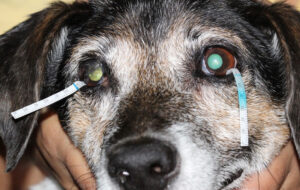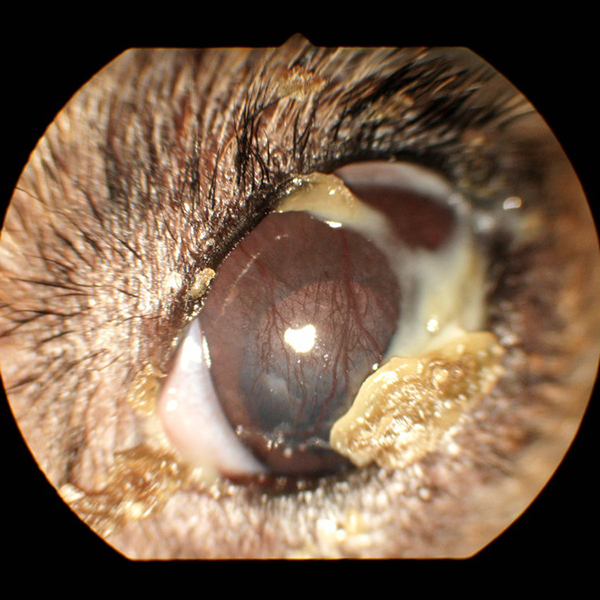Dr. Emilee Larkin explains the signs and symptoms of dry eyes in dogs, and what pet owners can do to help with their pet’s treatment.

Tears and tear production are important factors when it comes to eye health. They can wash away debris and any infectious agents that can get into the eye, and they even have germ-fighting properties. When the eye’s tear film — the thin but complex layer of fluid coating the eye — does not contain enough tears, dogs (and people) are subject to a condition known as “dry eye.”
The medical condition for pets affected with dry eyes is called keratoconjunctivitis sicca (KCS) and is fairly common amongst dogs. Certain breeds of dogs are more prone to developing KCS, such as Shih Tzus, Pugs, Westies, and Cocker Spaniels.

Courtesy: American College of Veterinary Ophthalmologists
Signs & Causes
The most common cause of KCS is the immune system attacking the tear glands, leading to them not producing tears. Another cause of KCS is a congenital predisposition (basically the condition being passed down genetically). KSC can also be caused by some infectious diseases like Distemper, or metabolic diseases like Cushing’s, Diabetes, or Hypothyroidism. Sometimes a traumatic injury to the eye can cause KSC as well.
A tell-tale symptom of KCS is a thick yellow to light green mucoid discharge that basically looks like snot coming from the eye. You can also see inflammation of the eye, which can look like a light pink sheen over the eye. We diagnose KCS via the Schirmer Tear Test. This is basically a special piece of paper that we put against the eye and measure the distance the liquid travels in one minute.
Unfortunately, there is no cure, and KCS is a lifelong management condition. If left untreated, the dog will go blind and it can become very painful. That would be one of the rare times that we would consider enucleation (the surgical removal of the eye) with an otherwise healthy eye if we can’t manage the pain.
Treatment & Medications
At the time of diagnosis, your veterinarian will likely do a round of antibiotics and/or anti-inflammatories (into the eyes) to treat the inflammation, or secondary infection that might have occurred before diagnosis. Treatment is lifelong and can take some time and adjustment before it has stabilized.

Courtesy: Royal College of Veterinary Medicine
Topical immunosuppressives into the eyes such as tacrolimus or cyclosporine are the usual go-to’s for treating KCS. Tear replacements – basically eye drops to function as tears, but can’t really give often enough to make up the difference – are also used as a treatment for KCS.
Medications usually take about six to eight weeks to take full effect, but you’ll see some improvement in your dog’s eye pretty quickly. We’ll do a recheck after a month to see how your pet’s eye is improving before moving further along with treatment.
While side effects are rare, they can include slight irritation of the eyes. Extreme reactions can be the result of an allergic response to the medication. Signs of an allergic reaction include vomiting, seizures, hives, and swelling around the face.
Veterinarians who’ve specialized in Ophthalmology can perform parotid duct transposition surgery (moving one of the salivary ducts so it moistens the eyes) in extreme cases of KCS, or remove the eye if it can’t be saved.
It’s very important to follow your veterinarian’s instructions on treating your pet’s dry eyes to prevent the worst from happening before it’s too late.


